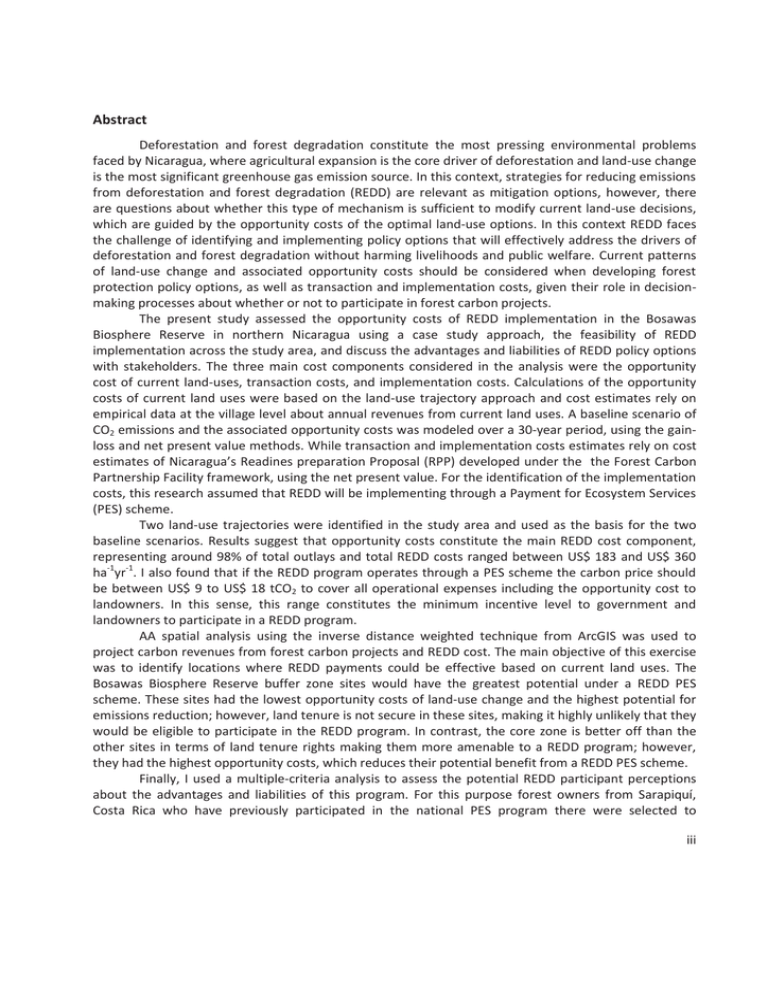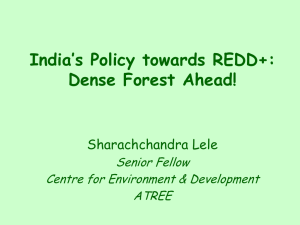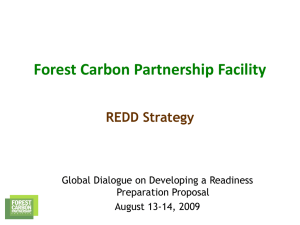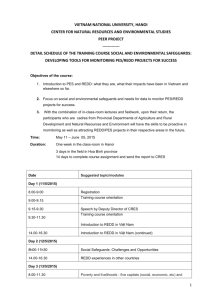Abstract
advertisement

Abstract Deforestation and forest degradation constitute the most pressing environmental problems faced by Nicaragua, where agricultural expansion is the core driver of deforestation and land-use change is the most significant greenhouse gas emission source. In this context, strategies for reducing emissions from deforestation and forest degradation (REDD) are relevant as mitigation options, however, there are questions about whether this type of mechanism is sufficient to modify current land-use decisions, which are guided by the opportunity costs of the optimal land-use options. In this context REDD faces the challenge of identifying and implementing policy options that will effectively address the drivers of deforestation and forest degradation without harming livelihoods and public welfare. Current patterns of land-use change and associated opportunity costs should be considered when developing forest protection policy options, as well as transaction and implementation costs, given their role in decisionmaking processes about whether or not to participate in forest carbon projects. The present study assessed the opportunity costs of REDD implementation in the Bosawas Biosphere Reserve in northern Nicaragua using a case study approach, the feasibility of REDD implementation across the study area, and discuss the advantages and liabilities of REDD policy options with stakeholders. The three main cost components considered in the analysis were the opportunity cost of current land-uses, transaction costs, and implementation costs. Calculations of the opportunity costs of current land uses were based on the land-use trajectory approach and cost estimates rely on empirical data at the village level about annual revenues from current land uses. A baseline scenario of CO2 emissions and the associated opportunity costs was modeled over a 30-year period, using the gainloss and net present value methods. While transaction and implementation costs estimates rely on cost estimates of Nicaragua’s Readines preparation Proposal (RPP) developed under the the Forest Carbon Partnership Facility framework, using the net present value. For the identification of the implementation costs, this research assumed that REDD will be implementing through a Payment for Ecosystem Services (PES) scheme. Two land-use trajectories were identified in the study area and used as the basis for the two baseline scenarios. Results suggest that opportunity costs constitute the main REDD cost component, representing around 98% of total outlays and total REDD costs ranged between US$ 183 and US$ 360 ha-1yr-1. I also found that if the REDD program operates through a PES scheme the carbon price should be between US$ 9 to US$ 18 tCO2 to cover all operational expenses including the opportunity cost to landowners. In this sense, this range constitutes the minimum incentive level to government and landowners to participate in a REDD program. AA spatial analysis using the inverse distance weighted technique from ArcGIS was used to project carbon revenues from forest carbon projects and REDD cost. The main objective of this exercise was to identify locations where REDD payments could be effective based on current land uses. The Bosawas Biosphere Reserve buffer zone sites would have the greatest potential under a REDD PES scheme. These sites had the lowest opportunity costs of land-use change and the highest potential for emissions reduction; however, land tenure is not secure in these sites, making it highly unlikely that they would be eligible to participate in the REDD program. In contrast, the core zone is better off than the other sites in terms of land tenure rights making them more amenable to a REDD program; however, they had the highest opportunity costs, which reduces their potential benefit from a REDD PES scheme. Finally, I used a multiple-criteria analysis to assess the potential REDD participant perceptions about the advantages and liabilities of this program. For this purpose forest owners from Sarapiquí, Costa Rica who have previously participated in the national PES program there were selected to iii participate in the discussion and two policy options were selected for this purpose. 1) inclusion of sustainable management of primary forest, natural forest regeneration and secondary forest management in PES scheme and 2) strengthening of institutions. Participants were requested to discuss the social, economic, institutional and environmental impacts of both policy options. Results indicated that both policy options will have positive impacts on environment, institutions and social aspects and will little contribute to enhance economic welfare of direct and indirect REDD beneficiaries. The results of this dissertation could serve in the decision-making process and policy design, providing key information about the minimum level of incentives where government and forest owners will be motivated to participate in a REDD program. The results can also serve as a basis for feasibility assessment, identify where REDD should focus and consider the multifold impacts of this type of forest policy protection. iv






